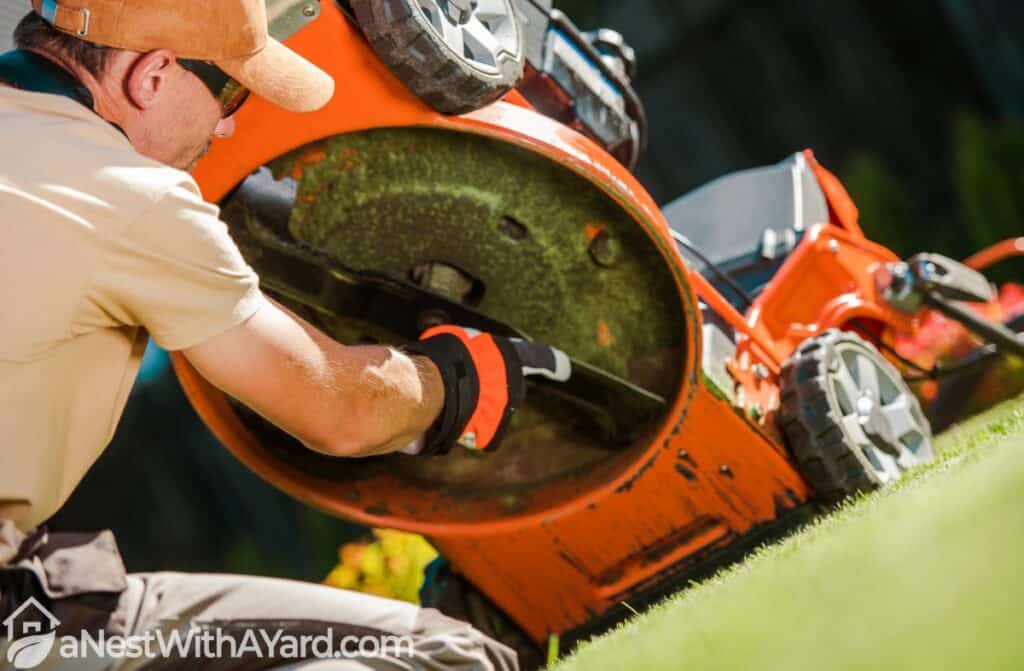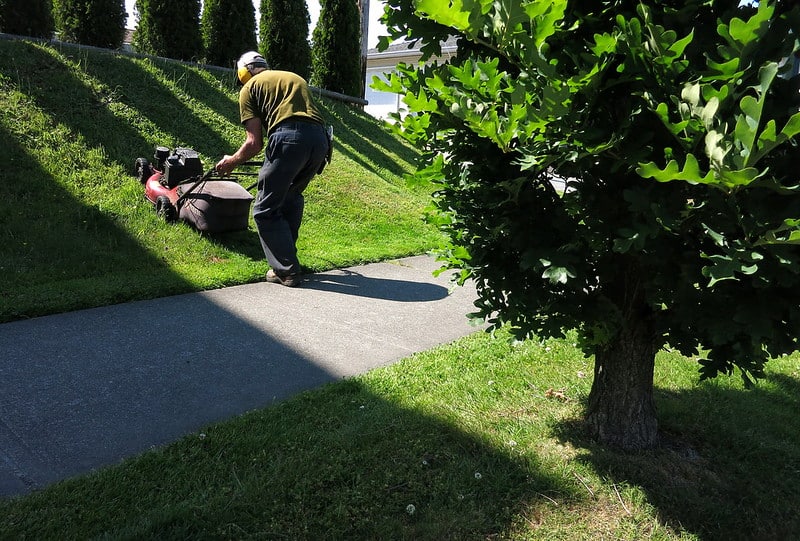It is best to allow your new lawn time to establish roots before mowing it for the first time. It can take anywhere from two to three weeks when using sod or up to two months before it could be ready to be mowed for the first time.
So you’ve just planted some grass seed in your yard, but now what? Should you just leave it to keep growing? Or should you cut it as soon as you see new growth so that it grows faster or will that cause damage? There are so many factors to consider!
I’m sure there are a couple of other questions that have crossed your mind when you think about how to tend to your new lawn but don’t worry, I’ve got you covered! Here’s everything you need to know about cutting grass for the very first time.

Contents
Cutting New Grass
If you’ve got a fairly new lawn and think you’re ready to give it a mow, you need to keep in mind that there are quite a few different types of grass out there and each has its own benefits, maintenance requirements and texture.
Naturally, if you’re choosing a type of grass to plant, the type you choose will depend on where you live as some tend to grow better in certain areas than others. Grass type also affects factors such as growing time, the method you would need to use to maintain it and the trimming techniques you ought to use.
Timing Your First Cut
The most exciting part of planting is when you start to see the results. While this depends on the type of grass you have, grass plants will generally take between 5 to 14 days after planting grass seed for young grass shoots to appear.
Timing is a critical factor to consider because if you mow your new lawn too early, you risk putting the new grass shoots under strain, resulting in hindered growth. If you mow too late, you won’t be able to thicken the sward while it’s still young enough.

Grass Height
You need to make sure that you are not trimming your lawn before it’s at a good height to cut. Waiting until it is the right height also gives the roots time to take hold. It’s also important to consider how low you cut your grass, as trimming it too short can damage it and it may not grow back properly. You should only cut around a third of the length at a time.
Grass Blade Strength
New grass blades are a lot weaker than that of established grass. Cutting grass can impose much stress on it when the mower passes over it and cuts the top of the blades. If your grass blades aren’t strong enough, they will uproot and ruin your new lawn.
Mower Blades

You should always ensure that your lawn mower blades are sharp. Using sharp blades has the aesthetic benefit of giving you a clean, straight cut. This clean cut also makes your lawn healthier, as clean-cut grass is able to recover faster.
Using a dull blade smashes the edge of the grass blades rather than giving a smooth finish. This damaged grass is more likely to be susceptible to both pests and disease.
Don’t Cut Wet Grass
It is very important to keep the seeded area moist during its growth period. However, it is also equally important to allow the soil and grass to dry out for 48 hours before moving it. This is because when grass is wet, the weight of the water causes it to clump, giving you a higher chance of a messier lawn cut, along with clogging up your mower.
One of the benefits of a healthy lawn is that it is able to fight off weeds and invasive grass easier, giving you a lusher lawn.
Don’t Rush Mowing
It is better to take your time when mowing your lawn. This is equally true for new grass, as a rushed cut can give your lawn an uneven look while also tearing through your grass blades.
Proper Mowing Techniques

You’ve worked hard to plant and tend to your new lawn. The last thing you want to do is ruin the fruits of your labor by mowing it incorrectly. In this section, I will go through some proper mowing techniques that’ll help you give your lawn care and proper maintenance.
Before you cut, you should make sure to pick up any debris so that your lawn mower doesn’t hit any rocks or stones and send them hurtling in all directions, or even worse, damage your machine.
The most common pattern to create for your lawn is stripes. However, it is recommended that you alter your mowing pattern. This is to help stop the grass from becoming worn out from the lawnmower tire tracks and to keep it from becoming compacted.
After mowing your newly seeded lawn, you should also remove all grass clippings. This is because dead grass will prevent sunlight from reaching your other grass due to its weight.
Check out this video by Organo-Lawn of Boulder on YouTube for more information on the mistakes people often make when mowing their lawn and tips for proper lawn care:
Feeding New Grass
Choosing the right type of fertilizer for your grass seed is an important step in your journey to growing healthy grass.
Concentrated essential nutrients are provided by the fertilizer to the grass seeds and newly germinated grass. These nutrients are able to improve the health of your soil, which helps with resistance to a variety of things, including weeds and pests.
Soil that lacks these nutrients can make it more difficult to grow your lawn. A quick-release fertilizer is often a good choice for new grass, as the quick release of nitrogen and other nutrients into the soil helps to promote faster growth and stops weeds from cropping up.
Watering Your Lawn For The Best Grass

To get the best outcome from your new lawn, you need to ensure the soil is kept moist once you’ve planted it. It should not get soggy and should be kept moist consistently.
If your grass ends up getting too dry once it has begun to sprout, it will die and all your hard work will be ruined. The top couple of inches of soil then need to be kept moist once it has started to germinate and until it reaches the point where you can mow it.
You have to be careful that you don’t drown your grass, though. You need to find that sweet spot between too little water and drowning your grass. After the first mow, you can start to water it less, but still water it at least once a week, soaking the soil more deeply to encourage the roots to grow deep into the soil.
Overseeding
If you overseed your lawn, it is recommended that you leave the new lawn untouched until at least the 2 or 3-week mark. It is important to select the right timing when mowing an overseeded lawn as you want to allow the new grass to take root beforehand. While overseeding could sound like a bad thing, it can be the way to go if you’re trying to find a way to treat your thin and worn lawn. Want to learn more? Head here.
FAQs
Can You Wait To Mow New Grass?
You can wait to mow new grass. You need to be careful when you choose to cut your newly seeded grass. It’s better to wait to cut new sprouts as, not only do they need time for their roots to establish, but they also have weaker blades than full-grown grass.
When Should I Mow My Lawn After Seeding For The First Time?
You should mow your lawn after seeding for the first time around four weeks after your new seedlings germinate. However, for seeded lawns, it can take up to two months for them to be at mowing readiness.
How Long Does It Take New Grass To Thicken?
New grass takes around two months to thicken and cover up the bare patches on your lawn. The germination length varies with each type of grass but on average it takes the grass seeds about two weeks.
Will Grass Thicken On Its Own?
Grass will not thicken on its own. You need to help your grass to thicken by giving it the right amount of water and nutrients and maintaining it through proper mowing.
How Tall Should New Grass Be Before The First Mowing?
New grass should be around 2½ to 3½ inches in height before the first mowing. Reaching this height normally means it’s growing well and has well-established roots.
Ready To Cut Your New Lawn?
Growing grass may have seemed like a simple task when you started out, but as you can see, there are a few things that you need to take into consideration before you begin to cut this new grass you’ve planted.
Remember, keep your new grass seeds watered and fed, don’t cut it too early or too short, and use proper cutting and lawn care practices to give yourself the best chance at getting the lush and healthy lawn you desire.
If you found this article helpful, please leave us a comment below and share this with a friend!

I found your article most informative, and very helpful in addressing the questions I had about my newly planted lawn.
Thank You, Nadya!
You are very welcome Phyllis!